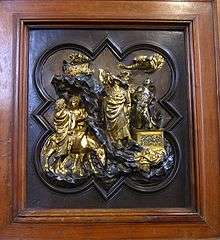Quatrefoil


In art, architecture, and traditional Christian symbolism,[1] the quatrefoil is a type of decorative framework consisting of a symmetrical shape which forms the overall outline of four partially overlapping circles of the same diameter. The word quatrefoil means "four leaves", from Latin quattuor, four, plus folium, a leaf.[2]) and applies to general four-lobed shapes in various contexts. It is also used as a heraldic charge.
Architecture history
The quatrefoil enjoyed its peak popularity during the Gothic and Renaissance eras. It is most commonly found as tracery, mainly in Gothic architecture, where a quatrefoil often may be seen at the top of a Gothic arch, sometimes filled with stained glass. Although the design is often referred to as "of Islamic origin", there are examples of its use that precede the birth of Islam by almost 200 years. The Monastery of Stoudous in Istanbul was built in 462 AD, soon after Christianity became legal in the Byzantine Empire. The arches seen are the product of taking a regular quatrefoil and dividing it in half.[3])
In ancient America

In ancient Mesoamerica, the quatrefoil is frequently portrayed on Olmec and Mayan monuments, such as at La Blanca, Guatemala where it dates to approximately 850 BC. The quatrefoil depicts the opening of the cosmic central axis at the crossroads of the four cardinal directions, representing the passageway between the celestial and the underworld.[4]
Another early example of a quatrefoil is found at Chalcatzingo, Morelos state, Mexico, the city that flourished between 700 BCE and 500 BCE. Both a full quatrefoil, and a partial portrayal of quatrefoil are found on monuments here. In the latter case, one half of a quatrefoil represents the opening of a cave where an important personage is seated. This cave opening represents a water source.
Thus, quatrefoil seems to be associated with water rituals. The associated imagery is related to agricultural fertility and the arrival of rain,[5][6] as evidenced by the rain-bearing clouds above the quatrefoil portal.[7]
The association between rulership and the quatrefoil symbol continued into the ensuing Late Preclassic period. A good example is found at Izapa.
The quatrefoil portrayal continued into the Classic period, as evidenced in the iconography of numerous Classic Maya monuments. A good example is the altar from El Perú (Maya site), which features a quatrefoil on the back of a zoomorphic creature in which sits a ruler. The associated hieroglyphic text refers to the creation narrative of the Maize god's rebirth.[7]
Barbed quatrefoil


The barbed quatrefoil is a quatrefoil pierced at the angles by the points of an inscribed square,[8] which gives an image akin to an heraldic rose, which is termed "barbed" due to the stylised thorns which project at the intersection of each pair of petals. The earliest example of the barbed quatrefoil appears on the south transept buttresses of 1260 in the Cathedral of Notre Dame in Paris.[8] Similarly the trefoil is often combined with an equilateral triangle to form a barbed trefoil. Among the most famous works of art employing the barbed quatrefoil are the bronze panels on the south doors of the Baptistery in Florence (1330–6) by Andrea Pisano, the bronze panels of the north doors of the Baptistery in Florence by Lorenzo Ghiberti, and also Filippo Brunelleschi's competition entry for the same doors, The Sacrifice of Isaac) as well as "Head of an Angel" by Piero della Francesca.
In heraldry
In heraldic terminology, a quatrefoil is a representation of a four-leaf clover, a rare variant of the trefoil or three-leaf clover. It is sometimes shown "slipped", i.e. with an attached stalk.
In military
In the U.S. Marine Corps, quatrefoil refers to a four-pointed decoration on the top of a warrant or commissioned Marine officer's dress and service caps (see peaked caps, also known in the Marines as "barracks covers"). According to tradition, the design was first used with Marine officers on sailing ships so that Marine sharpshooters in the rigging did not shoot their own officers on the deck during close-quarters gun battles (as when crews of opposing ships attempted to board each other's ship). An official part of U.S. Marine Corps officer uniforms since 1859, the quatrefoil was said initially to have been crossed pieces of rope sewed into officers' caps before becoming officially mandated as a uniform item.
Societies
The quatrefoil is the official symbol of the Bishop James Madison Society, est. 1812 at the College of William and Mary.
Fraternity
The quatrefoil is also the symbol in the USA of the women's fraternity Phi Mu (a member of the National Panhellenic Conference).
See also
References
- ↑ Our Christian Symbols by Friedrich Rest (ISBN 0-8298-0099-9), p. 36.
- ↑ Cassell's Latin Dictionary
- ↑ Slate (magazine). The Slate Group http://www.slate.com/blogs/the_eye/2014/03/20/the_quatrefoil_is_the_fanciest_shape_99_invisible_by_roman_mars.html. Retrieved 20 March 2014. Missing or empty
|title=(help) - ↑ Carolyn E. Tate, Yaxchilan: The Design of a Maya Ceremonial City. University of Texas Press, 2013 ISBN 0292739125
- ↑ GUZMAN, E. 1934. Los relieves de las rocas del Cerro de la Camera, Jonacatepec, Morelos. Anales del Museo Nacional de Arqueologia, Historia y Emografia Epoca 5, 1 (2): 237-51. Mexico City: Museo Nacional de Mexico: 241-43
- ↑ GROVE, D.C. 1968. Chalcatzingo, Morelos, Mexico: A Reappraisal of the Olmec Rock Carvings. American Antiquity 33: 486-91: 487
- 1 2 Love, M.; Guernsey, J. (2007). "Monument 3 from La Blanca, Guatemala: A Middle Preclassic earthen sculpture and its ritual associations". Antiquity. 81 (314): 920–932. doi:10.1017/S0003598X00096009.
- 1 2 Martindale, Andrew, Gothic Art, London, 1967, p.173
- The Artist Blacksmith, Volume 5, Number 4. www.Artist-Blacksmith.org.
- The Artist Blacksmith, Volume 6, Number 1, 2 & 3.
- The Hammers Blow, Volume 6, Number 4.
External links
| Wikimedia Commons has media related to Quatrefoils. |
- Pictures of Ghiberti's and Brunelleschi's quatrefoils
- Roman, Mars, "The Fancy Shape (Episode 106)." 99% Invisible. PRX, 17 March 2014. web: 21 March 2014.